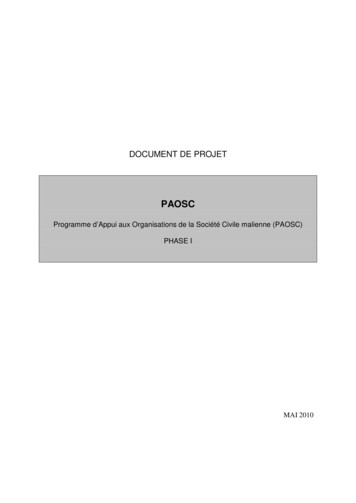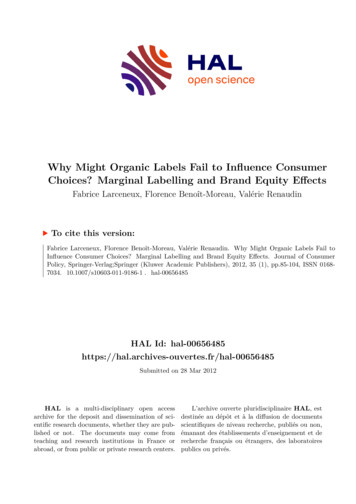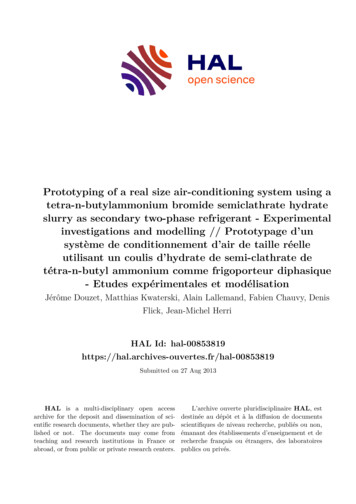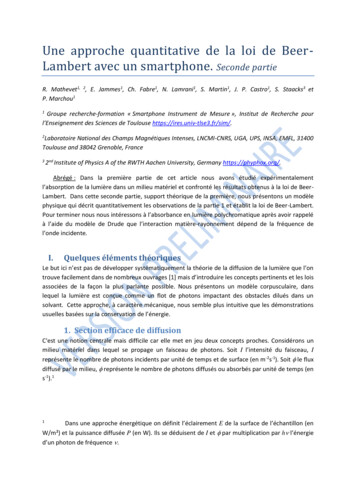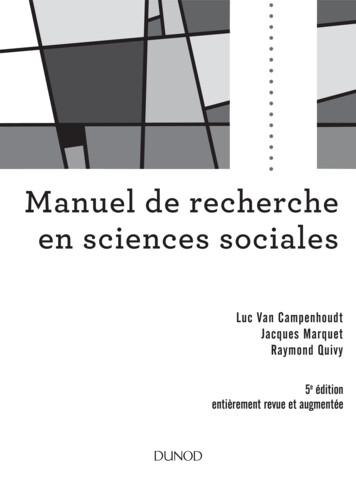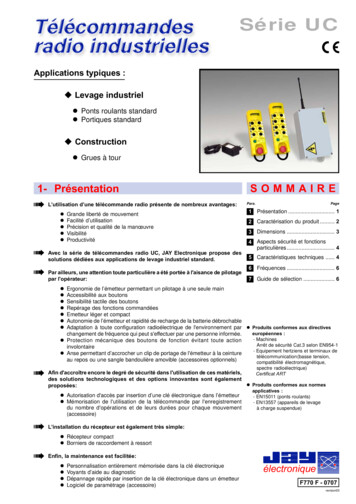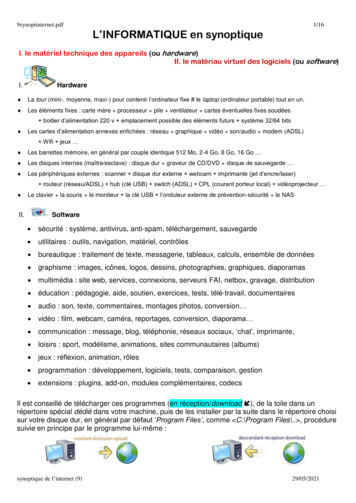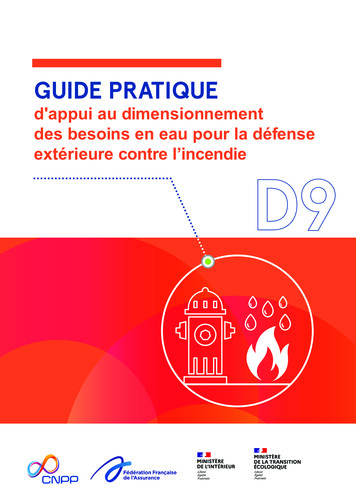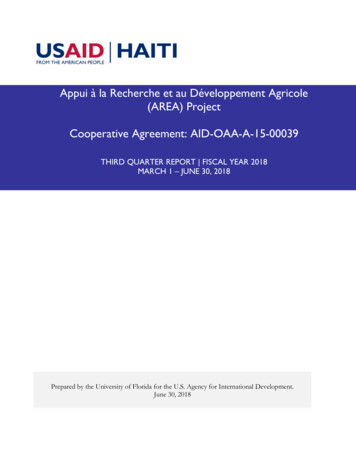
Transcription
Appui à la Recherche et au Développement Agricole(AREA) ProjectCooperative Agreement: AID-OAA-A-15-00039THIRD QUARTER REPORT FISCAL YEAR 2018MARCH 1 – JUNE 30, 2018Prepared by the University of Florida for the U.S. Agency for International Development.June 30, 2018
Table of ContentsAcronyms . 4Disclaimer . 5Project Background . 6Executive Summary . 7A. Climate Smart Solutions to Production Challenges . 8B. Collaborative Capacity Building in Maize Seed Systems .13C. Legume Research Program .14D. Plant Pathology .15E. Soil Science Research Program .20F. Launching Research Programs .26G. Mini-Grant Program .26H. MS and Grad Certificate Program .27I. Ministry of Agriculture .33J. Gender Assessments and Interventions .34K. Extension Experiment .35L. Higher Education Research .37M. Faculty Development Academy .39N. Postharvest and Food Safety Program .42Monitoring and Evaluation (M&E).45Appendix .50FiguresFigure 1. Overall, workshop participants reported an increase in knowledge of R-Instat, based ontheir own assessment of their skills. .11Figure 2. Marie Chrisnette St. Georges (right), a weather forecast presenter with the HaitiHydrometeorological Unit, stands with Drs. Caroline Staub and Roger Stern after the workshopon analyzing, interpreting and communicating about weather and climate data. .11Figure 3. Dr. Joubert Fayette co-leading the R workshop. .19Figure 4. These images show soil profiles in the Bretelle River watershed. .22Figure 5. Land use and land cover map derived from Landsat OLI for the Bretelle watershed studyarea. .23Figure 6. Map showing the soil fertility for beans in the Cul-de-Sac plain.25Figure 7. Graduate students Jean Maude Louizias and Josué St Fort flew to Haiti in May to beginwork on field experiments. .28Figure 8. Farmers participating in a group meeting. .362
Figure 9. Eighty-six percent of the respondents rated the overall organization of the conference asgood or excellent. .40Figure 10. Ninety-six percent of the respondents said they could apply what they learned at theconference.41TablesTable 1. Plant samples analyzed during the third quarter. .16Table 2. Average score (maximum 10) of participants in pre- and post-tests. .19Table 3. A summary of the research projects MS graduate students are working on. .28Table 4. Microbial analysis of the samples .44Table 5. Conference presentations and the research publications in Q3. .46Table 6. Breakdown of training events held during Quarter 3.47Table 7. Proportion of Female Participants in project’s activities, by program type. .49Table 8. Results from Quarter 3 (FY2018) .493
ADCIMMYTCOPCRDACRDDDFPEADIDORAgreement Officer’s RepresentativeAmelyorasyon Kapasite pou Ogmante Sekirite Alimantè an AyitiAssociation Nationale des Transformateurs de FruitsAppui à la Recherche et au Développement AgricoleCommunal Agricultural OfficeBoard for International Food and Agricultural DevelopmentA research laboratory associated with Quisqueya University's College ofAgricultureInternational Center for Tropical AgricultureCornell International Institute for Food, Agriculture and DevelopmentInternational Maize and Wheat Improvement CenterChief of PartyCentre de Recherche et de Documentation AgricoleRural Center for Sustainable DevelopmentDirection de Formation et de Promotion de l’Entrepreunariat AgricoleDirection of InnovationDirector of ResearchEMAEcoles Moyennes d’AgricultureFAMVIRBFaculté d’Agronomie et de Médecine VétérinaireInstitutional Review BoardLSULouisiana State UniversityMSMARNDRNAIPMaster of ERMinistère de l’Agriculture, des Ressources Naturelles et du DéveloppementNational Agriculture Investment PlanMonitoring and EvaluationNongovernmental OrganizationOrganisation pour la réhabilitation de l’environnementSupport to Agricultural Research and DevelopmentSolidarite Haitienne pour le Developpement Rural de KenscoffUniversity of FloridaUniversity of IllinoisUnited States Agency for International DevelopmentUnited States Department of Agriculture Service Agreement Participating AgencyWatershed Initiative for National Natural Environmental Resources4
DisclaimerThe authors’ views expressed in this publication do not necessarily reflect the views of the U.S.Agency for International Development or the U.S. Government.5
Project BackgroundIn May 2015, the University of Florida’s Institute of Food and Agricultural Sciences (IFAS) and twoother U.S. land grant institutions (the project consortium*) entered a five-year cooperativeagreement with the U.S. Agency for International Development to support its Feed the Futureinitiative in Haiti.The Appui à la Recherche et au Développement Agricole(AREA) project team’s approach to address the long-standingchallenges of food insecurity and under-nutrition in Haiti is tosupport public and private institutions that are working toimprove agricultural productivity. These institutions include theMinistère de l’Agriculture, des Ressources Naturelles et duDéveloppement Rural (MARNDR), Faculté d’Agronomie et deMédecine Vétérinaire (FAMV), and other higher educationinstitutions. The project builds on the Haiti’s NationalAgriculture Investment Plan (NAIP), which outlines dozens ofprojects designed to revive and modernize its agricultural sectorfollowing a devastating earthquake in January 2010.Consortium Members* The AREA project consortium’smembers are: The University ofFlorida, Louisiana State Universityand the University of Illinois atUrbana-Champaign. TheUniversity of Florida’s Institute ofFood and Agricultural Scienceleads the team.AREA and SARDThe AREA project also is knownas Support to AgriculturalResearch and Development(SARD). For clarity, the authorsuse AREA in this document.The project consortium is working to increase the availability ofimproved production technologies to farmers and the privatesector through effective extension and development of anagricultural innovation system. The rapid scaling up of proventechnologies is designed to increase adoption rates in the short term and propel the development ofnew technologies over the longer term. Developing functional and sustainable agricultural systemsrequires building on successful models and forging linkages to the national and international effortsalready in place in Haiti.Key Principles: The AREA project is guided by five key principles designed to build a sustainableagricultural innovation system in Haiti. These are:1. Provide opportunities for Haitians of all classes to improve their lives. Support training,innovation, well-implemented programs, and inclusive communication that will create waysto serve the needs of Haitian farmers. A special emphasis is to reach the country’s oftenoverlooked community of female farmers.2. Mentor agents of change in governmental and nongovernmental institutions andorganizations. Mentors provide guidance, training and knowledge that can help individualsincrease their confidence and build stronger leadership and problem-solving skills. The goalis to expand the number and effectiveness of change agents in the agricultural sector.6
3. Build and support stronger, more equitable farmer organizations and agribusinesses.Countries that meet their food needs have strong farmer organizations and agribusinessesthat play a key role in supporting farmer education and agricultural research. Establishingand improving the management of farmer cooperatives and organizations may helpovercome the limited access farmers, particularly women, have to credit and training.4. Foster a culture of evaluation, self-assessment and accountability. Professionals serving theagriculture sector are more effective when they develop skills that enable them to addressproblems, test solutions, accept responsibility and meet expectations. Research and effectiveinformation and technology delivery require credible information and equitable deliverymethods.5. Inspire educated and trained Haitians to fuel the growth of the agriculture sector throughinnovative research and extension. Enabling educated and trained individuals to contributeto and help rebuild Haitian agriculture will catalyze agricultural productivity. Fosteringentrepreneurial opportunities through business model incubators that support talentedresearchers and innovators can increase their long-term commitment and contributions toHaiti.——Executive SummaryAREA researchers accomplished a number of milestones and continued to make progress on keyresearch projects in the third quarter of fiscal 2018. Highlights are summarized below. AREA hosted the Innovation in Agricultural Education Conference, the first suchconference devoted exclusively to agricultural higher education in Haiti. One-hundred andthree U.S., Haitian and Ethiopian professors, students and researchers attended the academicgathering, which was devoted to innovations in agriculture and teaching methods.The Extension Experiment team completed the last of 875 interviews with farmers, whileAREA agronomists participated in 22 additional farmers’ association meetings as part ofAREA’s research to assesses farmers’ experiences with the groups and the adoption of newtechnologies, such as varieites of plants tailored to Haiti’s climate, improved storage bagsand peat-based seedling containers.In April, AREA’s Legume Breeding program planted newly improved generations of blackbean seeds in two locations in Haiti’s highlands, the latest development in the program’swork to cultivate higher-yielding lines of beans adapted to Haiti’s wide-range ofenvironmental conditions.The last AREA-funded graduate student from Haiti started her master’s program, bringingto 20 the number of master’s students studying agriculture at the University of Florida andLouisiana State University.Students began returning to Haiti to launch their required research projects, with one of thefirst a student’s experiment on 272 lines of sweet sorghum she is growing in differentconditions in Haiti to determine those that are most drought resistant, have the highest yieldand provide the most stem sugar content.7
Researchers gave six presentations at academic conferences, ranging from identifyingpriorities in developing climate services for Haiti’s agricultural sector to how Haitianagricultural faculty prepare for their academic roles.One of AREA’s lead researchers published an article on digital soil mapping in western Haitiin an academic journal in Brazil, while another submitted an article to a journal on the “SelfPerceived Readiness of Haitian Agricultural University Students to Enter the Workforce: ACall for Curriculum Reform.”Sixty-one Haitian agricultural students, faculty and professionals applied for competitivegrants of up to 20,000 as part of AREA’s mini-grant program to support researchers,encourage collaboration and address agricultural research priorities.More women were represented in project’s training and degree-granting activities thisquarter, with one-third of the participants female.Fiscal year 2018-2019 work plan meetingOn June 11-14, AREA’s team, including faculty and staff from the University of Florida’s Instituteof Agricultural Services in Gainesville, Florida, met in Haiti to plan activities for the project’s fourthyear, which runs from Oct. 1, 2018 to Sept. 30, 2019.Lead researchers provided updates on the progress of their programs and collaborated with AREA’smanagement team to refine their individual work plans for the upcoming year. On June 14, AREAresearchers and staff met with officials of the Haiti Ministry of Agriculture, the U.S. Agency forInternational Development and various project partners to present the preliminary work plan andgather feedback.The complete work plan, which is being finalized, will include information on budgets, staffing,project timelines and key activities.——A. Climate Smart Solutions to Production ChallengesThe goal of the Climate Smart Solutions program is to support Haitian institutions and itsagricultural sector in managing the risks associated with climate variability to reduce losses duringunfavorable years and maximize harvest in favorable ones. AREA is working to provide climateinformation and develop tools that farmers can use to improve planning and decision-making toreduce climate-related risks.Below are key accomplishments of AREA Climate Smart Solutions program in the third quarter ofYear 3.1. Wireless Weather Stations across Haiti and Climate Modeling SupportOutput 1: Create a portal for our partners to learn basic electronics, build and maintain weatherstations and access weather data.8
Beyond introducing weather station technology, AREA is interested in creating a long-termsustainable climate monitoring system that serves the needs of Haitian farmers. In April, Dr. BillEisenstadt, a professor of electrical engineering at the Unviersity of Florida and AREA’s climatestation specialist, and Dr. Caroline Staub, AREA’s technical coordinator and Climate SmartSolutions program leader, met with UF/IFAS Florida Automated Weather Network (FAWN)Director William Lusher to gain an understanding of the services and logistics of supplying weatherdata and associated services to farmers in Florida. AREA will continue to discuss with FAWNengineers and the staff at Haiti’s Hydrometeorological Unit to learn how to set up a sustainableclimate monitoring system in Haiti, while using lower-cost equipment and the skill set of Haitiprofessionals and university staff.Additionally, Eisenstadt revised a proposal to create a sustainable weather network in Haiti startingin the fourth year of the project. Under the proposal, he will lead an effort to provide AREA expertsand representatives from Haitian agricultural associations and Haitian universities with technicaltraining and expertise in programming and communications software. He also will work with AREAstaff to write technical support presentations, a journal article or conference papers about what hasbeen done and needs to be done for a sustainable Haitian weather network.Output 2: Workshop for Weather Data in Support of Day-to-Day Operations on the Farm in HaitiIn the third quarter, Eisenstadt prepared materials for a workshop entitled “Climate Smart Solutionsand 2nd Generation Weather Stations for Haiti.” AREA hired Haitian electronics consultant WillBlanc to translate the materials into French and Creole and to lead workshop, which will be held inHaiti Aug. 7. This workshop is designed to for professionals and university students in agricultureand related disciplines and will focus on teaching participants how to install, program andtroubleshoot upgraded stations.Output 3: Upgrade weather stations with new sensors and ways to collect and transfer data in areaswhere Wi-Fi service is limited or not available.During the quarter, Eisenstadt purchased parts to upgrade the electronic components for theweather stations AREA installed last year at Haitian agricultural research centers. He also purchasedthe components to build two upgraded weather stations as part of a workshop in August (seeOutput 2 above). Blanc plans to upgrade the existing weather stations at FAMV, the NationalAssociation of Agricultural Producers for the Advancement of Agriculture in Haiti (ANAPAAAH)in Croix des Bouquets, and the CRDDs at Bas-Boën, Montrouis and Wynne Farm in Kenscoff. Healso will install a new weather station at the American University of the Caribbean (AUC) in LesCayes. Parts will be on hand to install another station at an as-yet-to-be-determined location.After much development, the hardware and software of the second-generation station isfunctioning. Eisenstadt plans to add features to lower power consumption and make the softwaremore professional, robust and easy-to-maintain. The software and Wi-Fi communications continueto be refined. Eisenstadt hired an undergraduate programmer to assist in making the weather stationcode more functional.2. AREA Agroclimate Climate ProgramOutput 1: Needs Assessment, planning and preparation for the Agroclimate Training program.9
IRB protocol addendum development completed and approvedAny modification to questionnaires associated with research on human subjects requires approval byUF’s Internal Review Board (IRB). In April 2018, Staub continued to revise the focus groupinstruments based on a review of existing literature on agricultural decision making and climate riskmanagement in developing, primarily agricultural economies. In May, Staub and Dr. David Diehlfrom the AREA M&E team finalized the instruments and submitted them to the IRB, which gaveapproval. AREA plans to conduct additional focus groups with members of the agriculturalcommunity starting this summer. Data collected for agroclimate extension programDaily climate records are necessary to produce seasonal trends to discuss with farmers as part of theclimate extension program. In June 2018, the Climate Smart Solutions team obtained daily recordsfrom the Haiti Hydrometeorological Unit for use with farmers. The data require cleaning andprocessing before being used. Also, in June, Staub met with UHM coordinator Marcelin Esterlin andobtained a verbal approval of a partnership with AREA on the climate extension program. AnMOU is being drafted for formalize the agreement. Progress on manuscriptStaub also made progress on the literature review section of a manuscript that focuses on theintegration of local knowledge to inform climate risk management in Haitian agriculture. Theintroduction and methods section of this publication are being written in Year 3, while datacollection is underway through Year 4. Capacity building workshop on applied statistical analysis of climate data for use inagricultureAREA is seeking Haitian collaborators to produce historical climate data as part of the agroclimateextension program in Year 4. Staub teamed up with Dr. Roger Stern from the University of Readingto train 18 Haitian data analysts to analyze historical climate data in a way that is pertinent tofarmers. Seventeen percent of the participants were female. Upon completion of the two-dayworkshop, participants reported they gained confidence in their knowledge and skills in thefollowing areas, based on a scale of 1 to 5 (Figure 1).10
Figure 1. Overall, workshop participants reported an increase in knowledge of R-Instat, based ontheir own assessment of their skills.AREA hopes this activity will result in increased communication between UHM and Haitianagronomists, particularly during climate-risk management interventions on farms.Figure 2. Marie Chrisnette St. Georges (right), a weather forecast presenter with the HaitiHydrometeorological Unit, stands with Drs. Caroline Staub and Roger Stern after the workshop onanalyzing, interpreting and communicating about weather and climate data.11
Partnership between UF and Reading University finalizedIn June, the University of Florida and the University of Reading finalized their partnership on theagroclimate extension program. Outputs 3-5 have been postponed to the next growing season, inthe spring of 2019, with training starting by November 2018. This is necessary because climateadvisory services must be timed according to the growing season, which is well underway.Output 2. Agroclimate Training Part 1 - Gainesville, FlThis activity has been postponed to the first quarter of Year 4. See Output 1.Output 3. Agroclimate Training Part 2 – HaitiThis activity has been postponed to the first quarter of Year 4. See Output 1.Output 4. Agroclimate Training Evaluation Round 1This activity has been postponed to the first quarter of Year 4. See Output 1.Output 5: Producing Agroclimate Educational Resources for Haitian Educators Extension publicationA prototype of the AREA Climatology Tool was developed in Quarter 2 and will be refined inpartnership with UF’s Agricultural and Biological Engineering Department in the Q4. Additionally,they are developing an extension publication to describe the new tool and explain how it is used. InApril and May, Staub, Eisensdadt, and AREA team members Nicole Monval and Josue Dimanchedeveloped a second extension publication that will provide AREA partner institutions with specificson weather station siting and maintenance requirements. They finalized the manuscript andsubmitted English and Creole versions to the University of Florida’s Electronic Data InformationSource (EDIS). In June, Staub began addressing the first round of reviews received.Output 6. Climate module for FAMV Internship: Diagnosis of Agrarian SystemThis activity was completed in February 2018.Other activities: Ongoing Publications Book chapterIn June, Staub completed the climate section of a book chapter titled “Adapting diseasemanagement under global change,” focusing on recent trends and future projections of rainfall andtemperatures for Haiti. See literature citation in Section D.——12
B. Collaborative Capacity Building in Maize Seed SystemsThe development, production, dissemination and adoption by farmers of well-suited cultivars arekey components of a viable maize production system.The majority of farmers in Haiti use adapted but low-yielding maize cultivars that are acceptable toHaitian consumers. For farmers to change their traditional cultivar lineup and adopt new agriculturepractices to increase production, they need accurate information presented in an understandablemanner, so they can judge the risks and potential benefits.AREA is working with the International Maize and Wheat Improvement Center (CIMMYT) to trainfarmers in the production of seeds of improved maize varieties. With its germplasm collection andbreeding programs, CIMMYT is the leader in identifying maize cultivars suitable for production inHaiti. In addition, AREA will train agricultural professionals to design and implement variety trialsthat integrate participatory breeding evaluations by farmers.Output 1: Conduct train-the-trainer sessions using the corn seed production modules developed inYear 2Ludger Jean Simon, AREA’s maize research and extension specialist, worked with the staff of theBas Boën CRDD to organize a training on producing corn seeds. They plan to invite 30 participantsto the event, which is scheduled for August 2018.Output 2: Evaluate the implementation of seed production modules by the Haitian trainersNothing to report for this quarter.Output 3: Implement modules of standard operation procedures (SOPs) for conducting maizeexperimentsDr. Martin Bohn, a corn breeder at the University of Illinois, developed SOPs for designing andimplementing corn crop variety trials. The training modules include a field experiment checklist,field layout, seed information, field metadata collection, and phenotype and performance datacollection. Simon translated the module into Haitian Creole. AREA arranged for 11 Haitianprofessionals from the Ministry of Agriculture, colleges of agriculture and other organizations totravel to the University of Illinois at Urbana–Champaign for the training. The trip was set for July18-26 but was postponed because of civil unrest in Haiti. The training is being rescheduled forSeptember.Output 4: Evaluate the implementation of SOP modules by the Haitian trainers.Nothing to report for this quarter.Output 5: Introduce phenotyping equipment at the CRDDs (Bas Boën and Montrouis) andparticipating farmer organizations.13
Nothing to report for this quarter.——C. Legume Research ProgramThe objective of AREA’s Legume Breeding program (LBP) is to develop and release high-yielding,disease- and pest-resistant legume cultivars that have better tolerance for abiotic stresses comparedwith cultivars currently used by farmers in Haiti. The LBP focuses on genetic improvements oflegume crops — common beans, peanuts and pigeon peas. The peanut breeding work began as ajoint effort between AREA and a USAID project funded by the Feed the Future Peanut andMycotoxin Innovation Lab. AREA has taken over the peanut breeding work. Dr. Raphael Colbert,AREA’s legume breeder, and Dr. Barry Tillman, professor and peanut breeder in the AgronomyDepartment at the University of Florida, are collaborating on this effort.The legume germplasm evaluation, breeding and selection activities are being conducted at variousexperimental stations in the target region that represent different agroecological zones and climaticconditions. This increases the ability to develop new varieties that are adapted to a wide range ofenvironmental conditions. Trials conducted in Cabaret at CHIBAS – a research laboratoryassociated with Quisqueya University's College of Agriculture – and the CRDD in Bas Boën aim toselect germplasm that is adapted to lowland conditions and trials conducted at the CRDDs in theKenscoff region (including Robin and Duvier) that is adapted to highland conditions. At theselocations, the LBP evaluates the performance of different lines and varieties under low fertility inputconditions (with or without phosphorus). This includes evaluating their ability to produce nodulesand fix nitrogen (N) under low N conditions. In addition to these traits, the program selectsimproved lines for their resistance to common diseases, nematodes and insect pests and fordesirable phenotypic characteristics such as plant stature, earliness and overall yield performance.Output 1: Select and evaluate lines of common bean that are adapted to several agro-ecologicalzones in Haiti and possess desirable phenotypic and genotypic traits.On April 16, AREA planted common bean lines at the Duvier CRDD that had performed well inthe trials in the lowlands of Cabaret. These newly planted lines, which represent the progenies of F3and F5 generations, will now be evaluated for growing in Duvier’s highland conditions. AREA’slegume breeder will evaluate F3 and F5 bean populations to select F4 and F6 lines, respectively. Thebean plots were arranged in the field using a randomized complete block design. On June 29, AREAharvested the best-performing seeds, and these lines will be used in future evaluation trials.In April, AREA signed a service contract with Leogane, Haiti-based International Farmer’sOrganization for Sust
challenges of food insecurity and under-nutrition in Haiti is to support public and private institutions that are working to improve agricultural productivity. These institutions include the Ministère de l'Agriculture, des Ressources Naturelles et du Développement Rural (MARNDR), Faculté d'Agronomie et de
